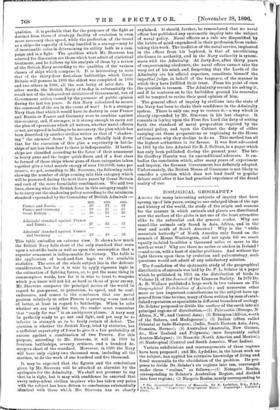ZOOLOGICAL GEOGRAPHY.*
AXONG the many interesting subjects of inquiry that have sprung up of late years, owing to our enlarged ideas of the age and history of the world, the study of the origin and reasons for the manner in which animals and plants are distributed over the surface of the globe is not one of the least attractive alike to the naturalist and the general reader. Why are camel-like animals only found in Asia, Africa, and in the west and south of South America ? Why is the "white mountain butterfly" of North America only found on the summit of Mount Washington, and not again till we reach equally isolated localities a thousand miles or more to the north or west? Why are there no moles or snakes in Ireland ?' —and soon, with a host of similar problems. And without the light thrown upon them by evolution and palmontology, such questions would not admit of any satisfactory solution.
The foundation of the systematic study of the geographical distribution of animals was laid by Dr. P. L. Sclater in a paper which he published in 1858 on the distribution of birds in -Volume II. of the Journal of the Linnwan Society. In 1876 Dr. A. R. Wallace published a large work in two volumes on The Geographical Distribution of Animals ; and numerous other more or less important contributions to the subject have ap- peared from time to time, many of them written by men of estab- lished reputation as specialists in different branches of zoology. Dr. Sclater proposed to divide the surface of the earth into six principal regions of distribution,—(1) Palwarctic (Europe, N- Africa, N., W., and Central Asia); (2) Ethiopian (Africa, south of the Sahara, and Madagascar) ; (3) Indian (often called Oriental or Indo-Malayan), (India, South-Eastern Asia, Java, Sumatra, Borneo); (4) Australian (Australia, New Guinea, &c., New Zealand and Polynesia) (now frequently called Austro-Malayan) ; (5) Nearctic (North America and Mexico); (6) Neotropical (Central and South America, West Indies).
Various subdivisions and rearrangements of these regions have been proposed ; and Mr. Lydekker, in the latest work on the subject, has applied his extensive knowledge of living and fossil mammalia to the elucidation of the problem. He pro- poses to divide Dr. Sclater's six regions into ten, rearranged under three "realms," as follows,—(1) Notoga3ic Realm, corresponding to Sclater's Australian Region, and divided into four regions ; (2) Neognic Realm, nearly corresponding to • The Geographical History of Mammals. By It. Lydehker. B.A.. .F.R.P... V.P.G.S., &c. "Cambridge Gemmtphical Series." Cambridge: Univers! y Press.
Sclater's Neotropical Region, but not extending quite so far north (one region only); and (3) Arctagitic Realm, comprising the remainder, divided into five regions,—the Malagasy and Ethiopian (Selater's Ethiopian); the Oriental ; the Holaretie (including Selater's Paltearctie and Nearctic) ; and the Sonoran (including small portions of the smith of Selater's Nearctic Region). The book is illustrated by a map, and by numerous woodcuts showing some of the characteristic living and fossil mammalia of the various regions, which are briefly but com- prehensively discussed in such a manner as to make the work useful for reference to the student, who will find it a convenient handbook either as an introduction to, or as an index to larger works on comparative anatomy and paleonto- logy. But the last word has not yet been said on geographical distribution. In the first place, Mr. Lydekker's conclusions are drawn from a study of the mammalia only (which are a comparatively small and obviously decadent class at the present day), and will have to be supplemented by data based upon the distribution of other and more dominant sections of animals and plants. Again, not only, as Mr. Lydekker admits, has the configuration and arrangement of the great continents varied much in different ages, and the regions of distribution at different periods varied accordingly, but he appears to attach too much importance to the indications afforded by palmontology in the arrangement of his regions. We are inclined to think that until we are able to map out the world as it existed at various epochs, and to study its fauna as then existing, as a whole, it would be better to base our regions of distribution rather on existing facts than on what may be deduced from fossil remains. Thus, although we may regard it as proved that elephants migrated into Africa from the north at a time when elephants were dis- tributed throughout the Northern Hemisphere, we arc hardly inclined to regard the fact as of sufficient importance to weigh against the claims of Africa south of the Sahara to rank as one of the principal zoo-geographical regions at the present day. Again, we should feel inclined to attach more importance to the Mediterranean and West Indian sub- regions than Mr. Lydekker seems disposed to do, while recent discoveries show a greater affinity between the insects of Madagascar and East Africa on the one hand, and Florida and the West Indies on the other, than had previously been supposed to exist.
There is one point to which we should like to call attention, which has been too much neglected by naturalists,—the examination of ancient, classical, and medimval authors for information respecting the geography and natural history of their times. The extermination of species has proceeded with great rapidity during the last three centuries, although it has always been going on ; and although the Greeks and Romans were no great navigators, the Arab voyagers of the early Middle Ages frequently sailed to China, Japan, Madagascar, and the Malay Archipelago, and some of them may well have reached the coasts of Australia, or even of America. That they frequently observed, and sometimes jotted down observations on extinct as well as on still existing animals, hardly admits of dispute, and may sometimes furnish us with some useful information of considerable interest and importance, as their notice of the cry of the bird of paradise (though embodied in a fable not unlike that of the barnacle goose) proves to us that they must have visited, or at least heard of, the Arn Islands. We find, by zoological and palitontological evidence, that the existing fauna of North America, so far as it is derived from the palieontic region, reached it yid Behring's Straits, and not by a Transatlantic route. This corresponds with Plato's information that Atlantis was an island, beyond which lay the continent (of America). After the island was destroyed by floods and earthquakes (apparently similar to those by which Port Royal and Lisbon, on opposite sides of the Atlantic, were destroyed within the last two centuries), the sea became impassable owing to "the gradually impeding mud which the subsiding island pro- duced" (as in the case of Krakatan, but on a vastly greater scale).
We are no advocates for the exclusive study either of science or literature, each of which has much more to learn from the other than its professors are always inclined to admit; and it would be a bad day for science itself if the study of the classics were discouraged at the Universities.
hope, there is less danger now than there might have been a few years ago.











































 Previous page
Previous page